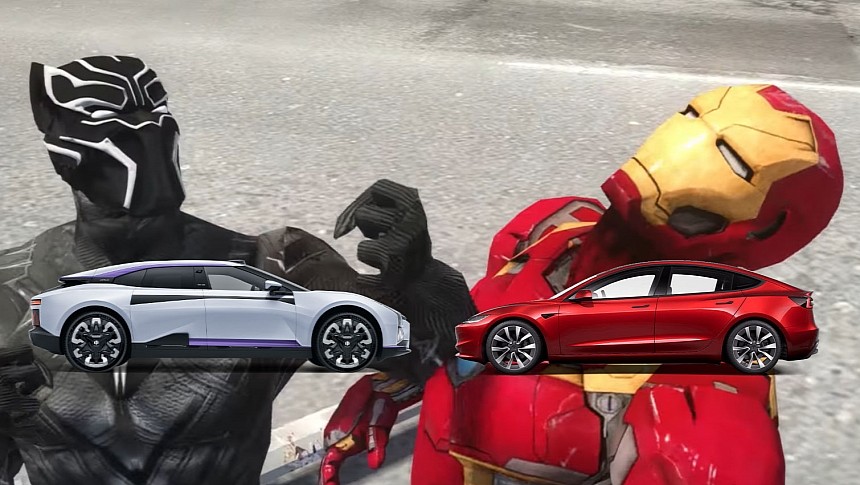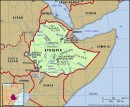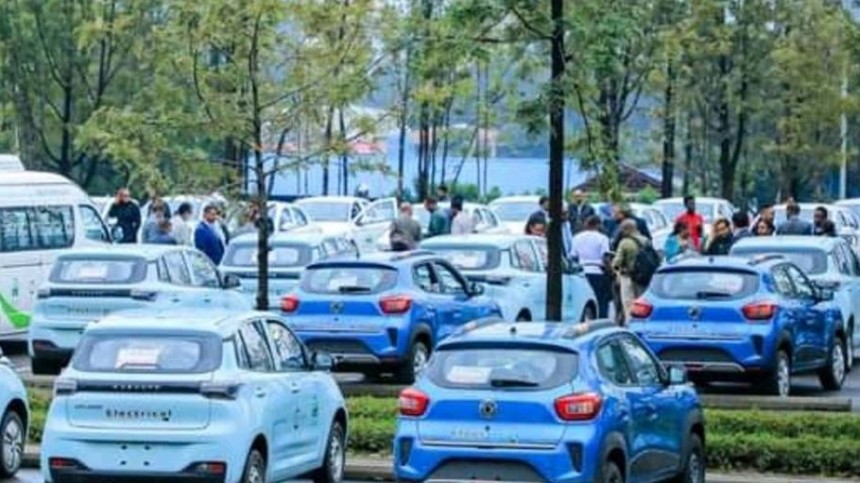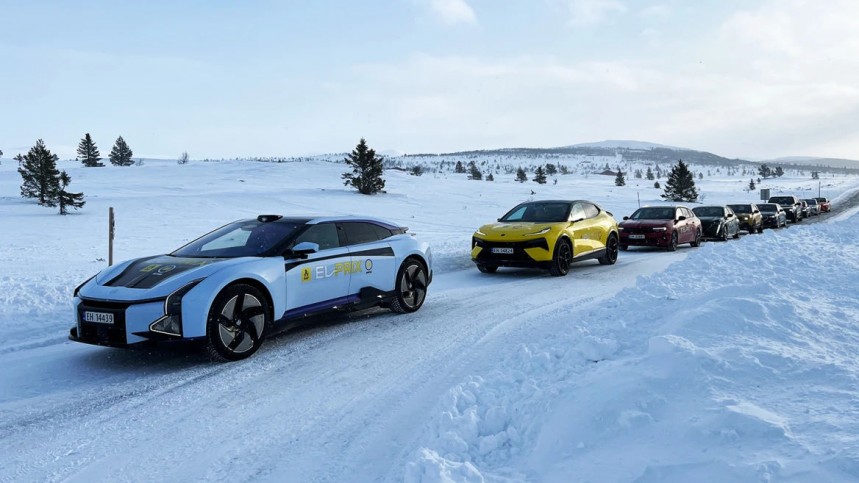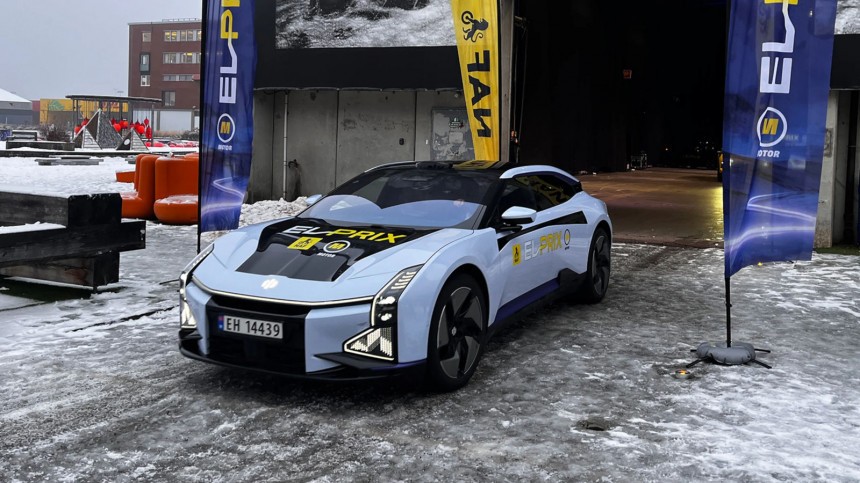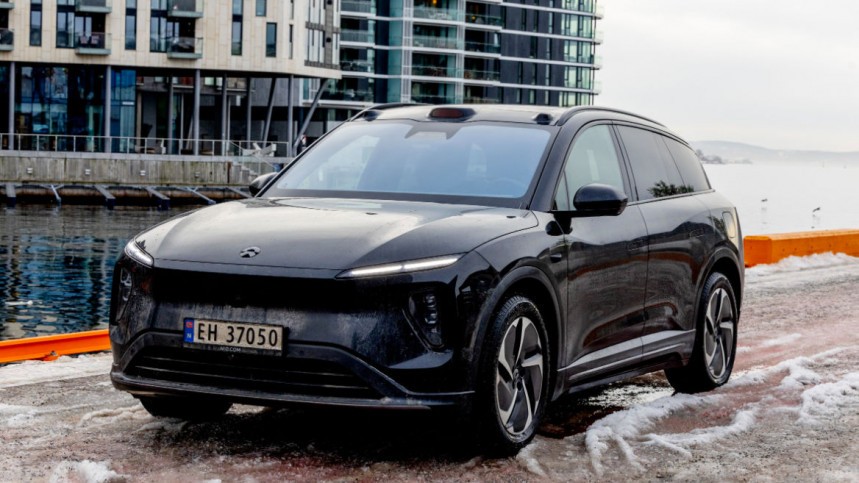Just a few days ago, Ethiopia's Ministry of Transport and Logistics announced that only electric vehicles will be allowed to be imported into the country. The measure is part of a "logistics master plan" – if this rings a bell, Mr. Musk, you should also know that the winner of the most recent EV range test in Norway's cold weather wasn't a Tesla but a HiPhi. Both news are sweet music for Chinese EV makers.
Let me ask you this: do you know where Ethiopia is located on the map? I'm sure most of you don't, and I'm like you. After all, it's not popular in the car industry's busy news world. But I bet most of you can instantly find Norway on the map, especially electroheads like me. This Northern European country is the world's leader in new car sales EV share.
Now, why should you care about Ethiopia and Norway in the same sentence? They both exempt electric cars from hefty taxes. Frankly, this is a clever form of subsidizing EVs instead of those complicated governmental incentivizing programs, which petrolheads call "unfair presents" and that extremist politicians easily use to inflame the large public.
But more important these days is the proximity to Yemen and the Red Sea, where Houthi rebels risk starting a new international war. It's a complicated geopolitical landscape for Ethiopia, among the poorest 50 countries in the world, so one can't seriously believe that electric cars could be a priority.
Well, here's another perspective to consider: Ethiopia is the second country in Africa by population (around 120 million people – a third of the US!), and it's regarded as one of the fastest-growing economies on the continent. If you're a global investor, this will surely capture your interest.
Of course, it's an exaggeration to compare real Ethiopia to Marvel's Wakanda kingdom. But the Black Panther would be proud of some members of the Ethiopian government. For instance, Alemu Sime, the Minister of Transport and Logistics, recently stated, "A decision has been made that cars can only enter Ethiopia if they are electric."
We don't know precisely when this ICE ban will be implemented, but it seems officials don't want to wait until 2035 or 2040, like other countries. There are also some comments about what the minister actually meant by that: was he referring to imports or the vehicles transiting Ethiopia? Well, I won't get into this stupid debate.
I will note that back in September 2022, the Ethiopian Ministry of Finance decided to exempt electric vehicles from VAT and other taxes and reduce their import fees drastically. The move aimed to support the 10-year plan of Ethiopia's Minister of Transport and Logistics to import around 5,000 electric buses and 150,000 electric cars.
It may seem too little, but you should keep in mind that the total number of registered vehicles in Ethiopia is barely 1.2 million units. Unsurprisingly, for a poor country where just a fraction of the population can afford a car. But there's also another factor.
Ethiopia has no oil reserves. The country has to import all of it, and it costs a lot. For instance, in 2023, it spent around $6 billion / €5.5 billion on all the gasoline and diesel needed for its vehicles. This is quite a lot, as 75% of Ethiopians earn less than $200 / €185 monthly. In fact, half of those who work have a salary of less than $150 / €140!
However, in the last two decades, Ethiopia has invested much in renewables, especially hydropower – just like Norway! It is estimated that this East African country has the potential to generate over 60 GW (60,000 megawatts) from renewables, which is double Norway's total installed production capacity.
By the way, Ethiopia plans to become carbon-neutral by 2025 – about two years from now… It's no wonder the government is pushing for zero-emissions transportation. And get this: while the gasoline price is around $5.2 per gallon / €1.27 per liter (more than the average price in the world), the cost of electricity for households is less than 1 cent/kWh.
Need I say more? Yes, I do. Thanks to tax-exempt, the Ethiopian market was flooded by Chinese cars, especially very cheap ones – many of them you won't ever see in the US or the EU because they simply aren't safe enough for Western standards.
I know there are some Spring-like EVs in the picture below, but remember that Dacia Spring was specifically upgraded for the European NCAP standards. The cars here are only good for markets with very relaxed safety standards, like Ethiopia.
The bottom line is that EV adoption in Ethiopia is more straightforward to implement because the market is basically in its infancy. New Chinese electric cars are already 40-50% cheaper than other EVs, and thanks to tax exemption and very cheap electricity, they are on par with gasoline and diesel cars. Funny thing, I remember when a Tesla Model S cost the same as a VW Golf in Norway…
"Nah, they won't buy those damn EVs because of range anxiety"
Thank you, naysayers, for pointing out what I call the Achilles heel. I recently touched on this subject in a two-part editorial, emphasizing that range will most likely remain the main culprit against EV adoption for a long time despite price parity and charging convenience.
Well, the Norwegian Automobile Federation (NAF) wants to prove me I'm wrong. Two times a year, NAF conducts an exciting experiment called El Prix. It's basically a range test, and this winter's edition is pompously presented as "the world's largest electric car test."
I should point out that NAF has around half a million members, a quarter of Norwegian drivers. So, it's not just some folks subjectively driving a few electric cars. The 2024 edition of the Winter El Prix (which tests all the cars under typical Nordic conditions) gathered an impressive number of 23 electric models.
You can only imagine the logistics needed to test all these cars on the same day under the same conditions. This is necessary for people like you and me to fairly compare the range and charging speed in freezing conditions. Basically, it's a comparison test in almost the worst-case scenario, with temperatures as low as -10 °C / 28°F, icy roads, and a lot of snow.
Earlier this year, the refreshed Tesla Model 3 won a similar range test in the Norwegian cold weather against nine other competitors. As the lowest temperature was below -20 °C / 4°F, with harsher conditions, one could think that NAF's test was an easy win for Tesla. Well, that wasn't the case.
But first, let's see the 23 contenders of the 2024 Winter El Prix:
So, we should take the HiPhi Z win over the 75 kWh battery Tesla Model 3 with a grain of salt. The most important thing to remember is that the big battery EV had the lowest difference between the theoretical optimum condition range and the real-world cold environment one – only 5.9%, compared to 29.9% for the Tesla Model 3.
The HiPhi Z managed to travel 522 km / 324 miles in freezing conditions, which is unbelievably close to the advertised WLTP 555 km / 344 miles. In fact, no other car in the test pack managed such a difference. The best following values were slightly over 12% (BMW i5 eDrive40, Lotus Eletre, KIA EV9).
For more than half of the cars tested, that percentage was more than 20%. The most significant differences (over 30% from the WLTP range) were recorded for VW ID.7, Toyota bZ4X, and Volvo C40. Most of the other EVs had an average loss of range of around 20-25%, which can be regarded as the norm for today's lithium-ion technology in cold weather.
Another critical factor, but definitely not as viral as the range loss, is the increase in consumption because of cold weather. In that regard, NIO's models in this test were impressive because their consumption was better than WLTP values!
The two Chinese models, the ET5 semi-break and the EL6 SUV, had average consumption values 10% lower than advertised. The closest competitor was KIA EV9, which showed only a 1% increase in cold weather compared to the WLTP value. HiPhi Z also performed well, with a less than 10% consumption increase.
Efficiency applause also goes to the Mercedes-Benz EQE SUV, BMW i5 eDrive40, MG4 Trophy Long Range, Nissan Ariya, BYD Dolphin, and XPeng G9, all with percentages varying between 4.7% and 7%. While such good efficiency values are expected from premium brands like Mercedes-Benz or BMW, it's impressive that two of the most affordable Chinese EVs sold worldwide are also in this rank.
Of course, I could blame China for its autocracy, for its presumably unfair practices to incentivize its industry in the shadows so that Chinese companies unfairly compete with Western ones, for its human rights problems, and the list can go on.
On the other hand, as the rEVolution really is the fastest way to decarbonize road transportation, I find China's push in this regard a good thing, as oddly it may sound. Yes, Ethiopia's EV market will be dominated by Chinese cars. Yes, Chinese batteries have an interesting edge.
But in the end, we all win as the air is less polluted by fewer and fewer ICE vehicles. While I reckon I'm reluctant on Made in China EVs (although I commute a cheap one!), I think we really need to spark this sensitive debate on how we CAN hasten the EV transition, but why we simply DON'T WANT to.
Now, why should you care about Ethiopia and Norway in the same sentence? They both exempt electric cars from hefty taxes. Frankly, this is a clever form of subsidizing EVs instead of those complicated governmental incentivizing programs, which petrolheads call "unfair presents" and that extremist politicians easily use to inflame the large public.
Ethiopia's curious nerve in the context
Let's get back to the map, shall we? One of its neighbors, Sudan, is torn apart because of a civil war; South Sudan in the West is considered to be the poorest country in the world; Somalia in the East is well known for its problems with famine and modern pirates.But more important these days is the proximity to Yemen and the Red Sea, where Houthi rebels risk starting a new international war. It's a complicated geopolitical landscape for Ethiopia, among the poorest 50 countries in the world, so one can't seriously believe that electric cars could be a priority.
Of course, it's an exaggeration to compare real Ethiopia to Marvel's Wakanda kingdom. But the Black Panther would be proud of some members of the Ethiopian government. For instance, Alemu Sime, the Minister of Transport and Logistics, recently stated, "A decision has been made that cars can only enter Ethiopia if they are electric."
We don't know precisely when this ICE ban will be implemented, but it seems officials don't want to wait until 2035 or 2040, like other countries. There are also some comments about what the minister actually meant by that: was he referring to imports or the vehicles transiting Ethiopia? Well, I won't get into this stupid debate.
I will note that back in September 2022, the Ethiopian Ministry of Finance decided to exempt electric vehicles from VAT and other taxes and reduce their import fees drastically. The move aimed to support the 10-year plan of Ethiopia's Minister of Transport and Logistics to import around 5,000 electric buses and 150,000 electric cars.
It may seem too little, but you should keep in mind that the total number of registered vehicles in Ethiopia is barely 1.2 million units. Unsurprisingly, for a poor country where just a fraction of the population can afford a car. But there's also another factor.
Renewables are simply better and cheaper than oil
Norway is rich in oil reserves. That's why back in 1990, the country was able to implement a one-of-its-kind incentive program: the purchase or import tax exemption for electric vehicles. Three decades later, Norway reached an unbelievable 90% EV share of new car sales, and in 2025, it plans to ban new ICE vehicle sales.Ethiopia has no oil reserves. The country has to import all of it, and it costs a lot. For instance, in 2023, it spent around $6 billion / €5.5 billion on all the gasoline and diesel needed for its vehicles. This is quite a lot, as 75% of Ethiopians earn less than $200 / €185 monthly. In fact, half of those who work have a salary of less than $150 / €140!
However, in the last two decades, Ethiopia has invested much in renewables, especially hydropower – just like Norway! It is estimated that this East African country has the potential to generate over 60 GW (60,000 megawatts) from renewables, which is double Norway's total installed production capacity.
By the way, Ethiopia plans to become carbon-neutral by 2025 – about two years from now… It's no wonder the government is pushing for zero-emissions transportation. And get this: while the gasoline price is around $5.2 per gallon / €1.27 per liter (more than the average price in the world), the cost of electricity for households is less than 1 cent/kWh.
Need I say more? Yes, I do. Thanks to tax-exempt, the Ethiopian market was flooded by Chinese cars, especially very cheap ones – many of them you won't ever see in the US or the EU because they simply aren't safe enough for Western standards.
I know there are some Spring-like EVs in the picture below, but remember that Dacia Spring was specifically upgraded for the European NCAP standards. The cars here are only good for markets with very relaxed safety standards, like Ethiopia.
"Nah, they won't buy those damn EVs because of range anxiety"
Thank you, naysayers, for pointing out what I call the Achilles heel. I recently touched on this subject in a two-part editorial, emphasizing that range will most likely remain the main culprit against EV adoption for a long time despite price parity and charging convenience.
Well, the Norwegian Automobile Federation (NAF) wants to prove me I'm wrong. Two times a year, NAF conducts an exciting experiment called El Prix. It's basically a range test, and this winter's edition is pompously presented as "the world's largest electric car test."
I should point out that NAF has around half a million members, a quarter of Norwegian drivers. So, it's not just some folks subjectively driving a few electric cars. The 2024 edition of the Winter El Prix (which tests all the cars under typical Nordic conditions) gathered an impressive number of 23 electric models.
Earlier this year, the refreshed Tesla Model 3 won a similar range test in the Norwegian cold weather against nine other competitors. As the lowest temperature was below -20 °C / 4°F, with harsher conditions, one could think that NAF's test was an easy win for Tesla. Well, that wasn't the case.
But first, let's see the 23 contenders of the 2024 Winter El Prix:
- Audi Q8 e-tron Sportback
- BMW i5
- BYD Dolphin
- Ford F-150 Lightning
- HiPhi Z
- Hyundai Ioniq 6
- Hyundai Kona Electric
- Jeep Avenger EV
- KIA EV9
- Lotus Eletre
- MG4 Trophy Extended Range
- Mercedes-Benz EQE SUV
- NIO EL6
- NIO ET5
- Nissan Ariya
- Opel Astra Sports Tourer Electric
- Peugeot e-308
- Polestar 2 Long Range
- Tesla Model 3 Long Range
- Toyota bZ4X
- Volkswagen ID.7
- Volvo C40 Recharge
- XPeng G9
Hi five Z-Generation? No, HiPhi Z steals the ice crown from Tesla Model 3
Comparing the compact sedan from Tesla to the twice pricier, heavier, and larger newcomer HiPhi Z is like comparing apples to oranges. In fact, the Chinese weird-looking 5-door liftback, with a 120 kWh battery, rivals the Tesla Model S Long Range, with a 100 kWh battery and similar performance but a better maximum range.So, we should take the HiPhi Z win over the 75 kWh battery Tesla Model 3 with a grain of salt. The most important thing to remember is that the big battery EV had the lowest difference between the theoretical optimum condition range and the real-world cold environment one – only 5.9%, compared to 29.9% for the Tesla Model 3.
The HiPhi Z managed to travel 522 km / 324 miles in freezing conditions, which is unbelievably close to the advertised WLTP 555 km / 344 miles. In fact, no other car in the test pack managed such a difference. The best following values were slightly over 12% (BMW i5 eDrive40, Lotus Eletre, KIA EV9).
Another critical factor, but definitely not as viral as the range loss, is the increase in consumption because of cold weather. In that regard, NIO's models in this test were impressive because their consumption was better than WLTP values!
The two Chinese models, the ET5 semi-break and the EL6 SUV, had average consumption values 10% lower than advertised. The closest competitor was KIA EV9, which showed only a 1% increase in cold weather compared to the WLTP value. HiPhi Z also performed well, with a less than 10% consumption increase.
Efficiency applause also goes to the Mercedes-Benz EQE SUV, BMW i5 eDrive40, MG4 Trophy Long Range, Nissan Ariya, BYD Dolphin, and XPeng G9, all with percentages varying between 4.7% and 7%. While such good efficiency values are expected from premium brands like Mercedes-Benz or BMW, it's impressive that two of the most affordable Chinese EVs sold worldwide are also in this rank.
In the end, a total ICE ban is possible, while the EV range in cold weather is not that bad
Ethiopia's recent proposal and NAF's latest test in cold weather are excellent examples of EV adoption not being stalled. While China is the clear winner in both cases, I think it's time to ask ourselves if this really is bad.Of course, I could blame China for its autocracy, for its presumably unfair practices to incentivize its industry in the shadows so that Chinese companies unfairly compete with Western ones, for its human rights problems, and the list can go on.
But in the end, we all win as the air is less polluted by fewer and fewer ICE vehicles. While I reckon I'm reluctant on Made in China EVs (although I commute a cheap one!), I think we really need to spark this sensitive debate on how we CAN hasten the EV transition, but why we simply DON'T WANT to.
